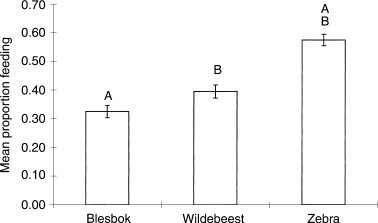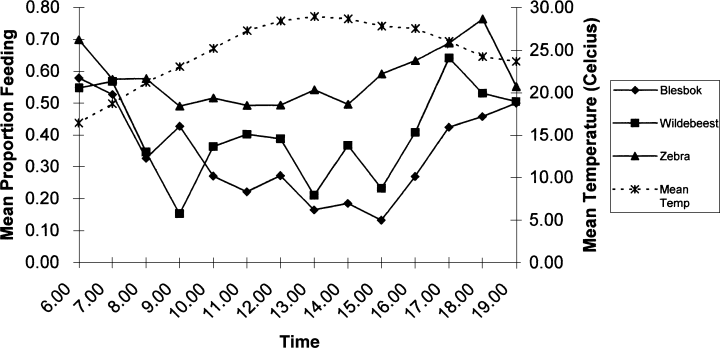Feeding time budgets of selected African ruminant and non-ruminant grazers
Introduction
In order to meet its nutritional and energetic requirements, an animal must allocate a certain proportion of its overall activity time budget to feeding. The time allocated to feeding will be influenced by the digestive efficiency of the animal. Digestive efficiency for roughage is generally higher in ruminants than in non-ruminants (Foose, 1982; Beekman & Prins, 1989; Owen-Smith, 1992). In order to compensate for their lower efficiency, non-ruminants exhibit increased food intake and gut passage rates, thus maximizing extraction of nutrients per unit time rather than per unit food consumed (Crawley, 1983). Gut morphology should therefore influence the time needed to feed to meet metabolic requirements.
Another component of an animal's feeding time budget is the time of day during which feeding activity occurs. In order to maintain its heat balance under high temperature conditions, an animal may have to reduce its feeding activity during the hottest hours of the day (Belovsky, 1978; Belovsky & Slade, 1986; Klein & Fairall, 1986). Endothermic species should thus reduce feeding activity in the hottest periods of the day, unless they have evolved a high heat tolerance, as may be expected in non-ruminants which have to maintain high food through-put rates.
This study tested the following hypotheses:
- 1
Ruminants allocate a lower proportion of diurnal activity time to feeding than non-ruminants.
- 2
Ruminants reduce feeding activity in hot weather, while non-ruminants do not.
Materials and methods
Study area and species
The study was conducted in the Suikerbosrand Nature Reserve, Gauteng Province, South Africa. The terrain is hilly and the vegetation consists primarily of sour grassland and Acacia karoo woodland. The reserve falls within the Bankenveld and Cymbopogon-Themeda veld vegetation type, according to Acocks (1988).
Two ruminant species, blesbok (Damaliscus dorcas subs. phillipsi) and black wildebeest (Connochaetes gnou) and the non-ruminant Burchell's zebra (Equus burchellii) were selected for this study because they are all grazers and usually occur together in open grasslands.
Experimental design and data collection
A site in which herds of all three species were present was located each morning. Hourly scan samples were taken, in which the total number of visible individuals within each species, as well as the numbers of individuals feeding at the time of the scan, were determined. This allowed for the calculation of the proportion of animals feeding within each species at a given time.
Feeding referred to the entire process of grazing, excluding movement in search of food. Ruminating was not classified as feeding. Only adults were sampled to avoid potential biases which may have arisen due to possible differences in adult and juvenile feeding activities. Observations were made from a vehicle wherever possible, using a high-power telescope from a distance at which the animals were not disturbed by the presence of the observer. Air temperature was measured hourly.
Three sites were sampled over the study period. Because these the study species feed predominantly during the day (Klein & Fairall, 1986; Beekman & Prins, 1989; Skinner & Smithers, 1990), measurements were made between 06:00 h and 19:00 h. Eleven full days of data were collected for each species during December 1992 and January 1993.
Data analysis
The proportion of animals feeding was used as a measure of time spent feeding by individuals within a species. An arcsine transformation was carried out on the data to ensure that the data set was parametric. One-way anova and Scheffe Multiple Range tests were then carried out on the arcsine transformed data to determine if mean proportion of animals feeding differed significantly among species. Linear regression analysis was conducted to examine the relationship between hourly feeding activity and hourly temperature for each of the three species.
Results and discussion
Daily feeding budgets
The mean daily proportion of animals feeding differed significantly (P < 0.001) between blesbok and zebra and between wildebeest and zebra, but not between blesbok and wildebeest (Fig. 1). Zebra allocated ≈ 60% of their time to feeding, while blesbok and wildebeest allocated ≈ 35%. This means that zebra spent an average of 8.5 h of a total of 13 daylight hours feeding, while the two ruminant species spent approximately 5 h feeding (59% of zebra feeding budget). Therefore, as predicted, the non-ruminant species allocated significantly more time to feeding than the two ruminant species.

Mean proportion of animals feeding during a 13 h summer diurnal study period (n = 11), showing standard errors. The letters A and B denote significant differences (Scheffe's test). F = 33.535, P < 0.001 and df = 426
Burchell's zebra is the largest of the three species (275–325 kg), but it is unlikely that the observed differences in feeding budgets could be ascribed to differences in body size. Black wildebeest have a mean body mass (136 kg) which is twice that of blesbok (70 kg), and yet this did not result in significantly different feeding time budgets between these two species.
The effect of temperature
Although all three species fed most actively in the early morning and around dusk, no strong relationship was found between feeding activity and temperature (Table 1). Zebra maintained a high feeding activity throughout the day, including the hottest period (12:00–14:00 h), and have probably evolved a high heat tolerance, necessitated by the need to sustain high food passage rates through the gut. The two ruminant species generally decreased feeding activity during these hours, but these trends were probably confounded by feeding activity oscillations assumed to be related to the rumen volume and the need to ruminate. However, blesbok are known to be sensitive to heat and are reported to generally rest during midday (Skinner & Smithers, 1990).
| Species | R 2 | Correlation coefficient | P-value (95%) |
|---|---|---|---|
| Blesbok | 0.150 | −0.387 | <0.001 |
| Black Wildebeest | 0.058 | −0.241 | 0.004 |
| Burchell's Zebra | 0.016 | −0.128 | 0.128 |
It is interesting to note that the feeding activity troughs displayed by blesbok and wildebeest, which are supposedly due to rumination, occur in the hotter hours of the day (Fig. 2). The ruminant species may thus take advantage of these energetically expensive hours to lie down and ruminate rather than forage.

Mean hourly proportion of individuals feeding and mean hourly temperature during the 13-h diurnal study period (n = 11)
Acknowledgements
I would like to thank N. Owen-Smith for supervision of this project and R. Slotow and an anonymous referee for valuable comments on earlier versions of the manuscript. I would also like to express gratitude to J. Fourie, the officer-in-charge of the Suikerbosrand Nature Reserve, for his kind permission to conduct this research at Suikerbosrand and for his assistance with accommodation and other logistics.




